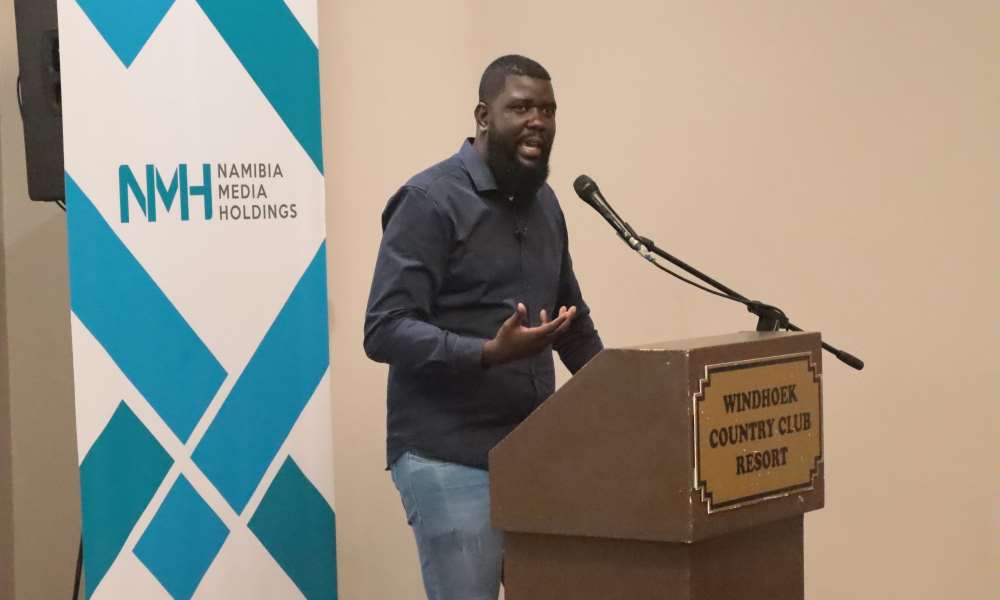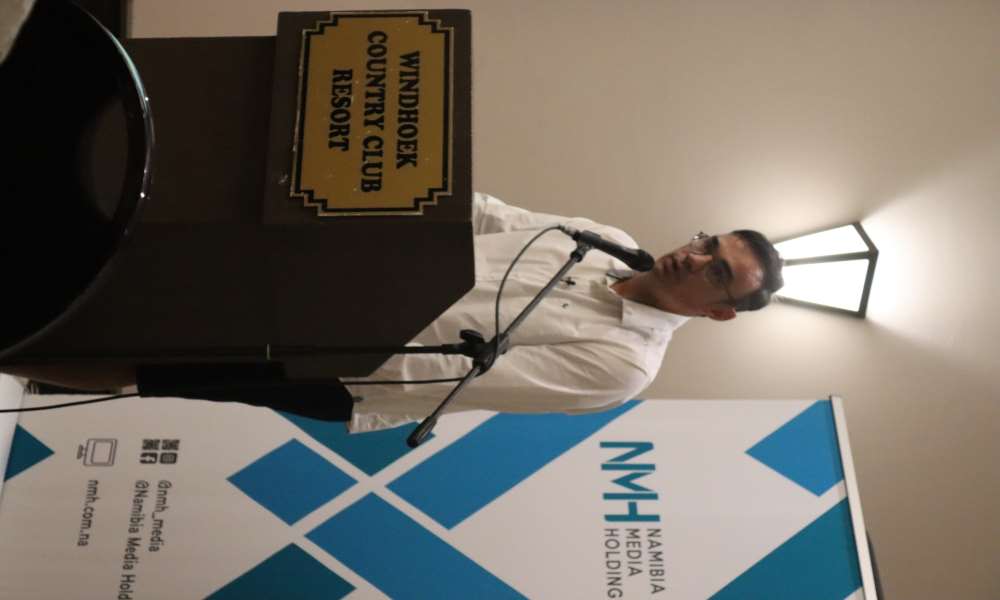Tourism Expo established as a regional event
‘Youth in tourism’ can become an economic catalyst
The seminars that formed part of the Tourism Expo raised pertinent issues and opportunities that were previously not recognised in Namibia. In the process, this year's theme, "Beyond Borders", assumed a much wider meaning than initially met the eye.
The Tourism Expo 2023 saw several changes which were welcomed by the industry.
In the past, the event took place from Wednesday to Saturday, with the exhibition stands being manned throughout the day. This year’s expo was conducted from Wednesday to Friday (26 to 28 April) and it opened from 16:00 to 22:00, which allowed exhibitors to opportunity to dedicate themselves to visitors during these focused hours while attending to normal business or taking part in the tourism industry seminars that were conducted from 11:00 to 16:00 on Thursday and Friday.
Jürgen Cronje, CEO of Komnik & Franck, the company that was awarded the Editor’s Choice Award by “Tourismus Namibia” and voted as the Stand of the Year by expo visitors, summed it up best: “It was a perfect occasion to introduce our products and services. Even though we sold a lot of products, we aimed to host the visitors and have them taste our wines and get to know our products. In that regard, I am more than satisfied.”
Sixty stands were availed to exhibitors, which ranged from the hospitality industry to the banking sector as well as all kinds of suppliers of goods and services, while another 24 stands were occupied by the Windhoek City Market's regular exhibitors. A total of 4 281 people visited the event over these three days.
But it was the seminars that were popular as they proved to be not only relevant but were found to raise interest among the audience mostly targeted: the youth of Namibia.
Youth in Tourism
The first day’s seminars saw the Director of Tourism and Gaming, Sebulon Chicalu, explaining the Namibian government’s agenda when it comes to involving the youth in the local tourism industry. It was here that things became actively engaging, setting the tone for subsequent seminars. The fact is that opportunities are available and it is in the interest of the youth to start engaging instead of waiting for themselves to be engaged.
This point come across clearly during the talk led by Marcheline Poldewitz from the Khoadi //Hoas Conservancy. She expanded on how to operate, market and sustain a conservancy, which boils down to the will of the people concerned to make it work.
Finance available
Nabot Mbeeli of the Namibia Nature Foundation (NNF) and Senior Coordinator for CBNRMs on Friday spoke about funding opportunities for youth in conservation. The Community-Based Natural Resource Management Programme resorts under NACSO and the Namibia Nature Foundation. He explained the community-based and sustainable conservancy principle. This resulted in an interesting discussion about what needs to be done to register a conservancy.
A contributor to the general discussion, Seimy Christoph-Shidute of the Ministry of Environment, Forestry and Tourism, subsequently challenged the youth to start becoming solution-minded instead of waiting for things to happen for them.
Mbeeli pointed out that 20% of Namibia’s surface area comprises conservancies and nature parks. He assured the youth that NGOs are already involved and suggested that these NGOs and the US Embassy are ideal partners to engage with. The US Embassy has systems in place that allows candidates to present their proposals and possibly qualify for their start-up grants programme valued between N$5 000 and N$25 000.
Internships
Speaking about internships in the tourism sector, the CEO of Gondwana Namibia, Gys Joubert, put the importance thereof into perspective: “Once we have zero youth unemployment, we have done enough!”
Joubert reflected on Gondwana’s track record in terms of improving the chances for youth to become involved in tourism: “We can always do more, but last year, at a time when we employed just a little more than 1 000 people, we took in 108 interns for training from 23 training providers. And it works for us!”
However, students need to seize the opportunity and differentiate themselves by adding specific value, Joubert said.
Commenting on this requirement, Gitta Paetzold of the Hospitality Association of Namibia (HAN) said that tourism is a “passion and attitude-based occupation”.
Joubert believes that practical training is a must in any industry and that applies to tourism, too: “We all need a pool of expertise.”
He advised companies to make use of the incentives offered by the NTA, which receive the VET levy that is paid by all employers. However, he questioned the buy-in of the NTA at a regional level, as “Vocational Training Centers are not properly utilised”, especially in rural areas.
'Brits want sun!'
The British High Commissioner to Namibia, Charles Moore, added a different perspective to the seminars on Thursday, when he spoke about what he believes Namibia offers, conversely expressing his view about what visitors may expect when coming here.
Moore found Namibia to be a very welcoming community, which allows visitors to not stand out as a tourist, but rather be welcomed into the community, “a real home away from home”. He lamented the fact that Namibia is hardly known in the UK.
Having travelled more than 50 000 km on Namibian roads, he is serious about promoting the country as a destination: “I am doing my level best to get British Airways to consider Namibia as a stop-over on their way to South Africa. If at all, it will not happen overnight, but it would certainly serve the purpose of improving Namibia as a destination for Brits.”
The predicament though is: “Brits want sun!” While Namibia does have sun even in winter (summertime, i.e. holiday in the UK), it does not change the fact that it is cold, according to the High Commissioner. He found the UK’s midterm school break to coincide with October, which could serve Namibia’s tourism sector well.
He did however point to the fact that Namibia comes across as a very expensive destination, even though a visit may offer value for money. He criticised Windhoek as a "seriously boring place" that only offers dilapidated museums, which mostly serve as tourism information bureaus.
Sport and tourism
Johan Muller, the CEO of Cricket Namibia, identified sport as a tourism driver on Friday. “Sport is a tourism generator that we are not tapping into.”
He used Google Analytics to illustrate how a T20 World Cup cricket game had a direct correlation with statistical data showing how people suddenly googled Namibia and thus started taking an interest in the country.
He suggested that sports events would encourage people to consider the country as a holiday destination. In a typical manner the search “Namibia Tourism” proved to correlate with the exact time that a T20 match was being played. Muller emphasised the fact that in the case of cricket, the games are broadcast in 220 countries by 26 broadcasters – the ICC records 1.3 billion fans. “That is the pool that will recognise Namibia as a possible destination.”
Muller believes that the impact of sport on a country's economy is underestimated. The direct link between the marketing value of sport in a country as well as the stimulation of a country's economy is invaluable, he added. He specifically referred to so-called mega-events, such as the various ICC World Cup, the World Cup, which is held every four years, and the Olympic Games.
He believes that the u/19 World Cup in 2026 and the Senior Men's World Cup in 2027 – based on available 2019 data – should be able to generate U$ 26 million that will flow directly into Namibia. This cash flow would likely be generated in the form of accommodation bookings, transport and local products and services, "not to mention people staying a few extra days to holiday and visit our beautiful country".
Trans-boundary parks
Seimy Christoph-Shidute appreciated the expo as an opportunity handed to the industry, allowing it to exchange ideas. She insisted that the Namibian private sector should be present at the seminars “as it is here where new ideas are born; ideas that can turn into employment opportunities for sectors such as construction, transport and many others”.
She pointed to the importance of multi-dimensional parks such as the /Ais-Ais-Richtersveld Trans-Frontier Conservation Area, the Kavango-Zambezi TFCA and the Iona-Skeleton Coast TFCA – incidentally, all parks that featured in the latest Tourismus Namibia magazine that was published before the Expo.
Shidute indicated that the Iona-Skeleton Coast Park is due to be extended along the entire Namibian coast to reach down to the north-western coast of South Africa. With an approximate size of 107 000 km², it would become the biggest TFCA in Africa, opening up huge opportunities.
In this regard, she assured the audience that it is only a matter of time before the multi-purpose visa for Southern African countries would be introduced.
In the past, the event took place from Wednesday to Saturday, with the exhibition stands being manned throughout the day. This year’s expo was conducted from Wednesday to Friday (26 to 28 April) and it opened from 16:00 to 22:00, which allowed exhibitors to opportunity to dedicate themselves to visitors during these focused hours while attending to normal business or taking part in the tourism industry seminars that were conducted from 11:00 to 16:00 on Thursday and Friday.
Jürgen Cronje, CEO of Komnik & Franck, the company that was awarded the Editor’s Choice Award by “Tourismus Namibia” and voted as the Stand of the Year by expo visitors, summed it up best: “It was a perfect occasion to introduce our products and services. Even though we sold a lot of products, we aimed to host the visitors and have them taste our wines and get to know our products. In that regard, I am more than satisfied.”
Sixty stands were availed to exhibitors, which ranged from the hospitality industry to the banking sector as well as all kinds of suppliers of goods and services, while another 24 stands were occupied by the Windhoek City Market's regular exhibitors. A total of 4 281 people visited the event over these three days.
But it was the seminars that were popular as they proved to be not only relevant but were found to raise interest among the audience mostly targeted: the youth of Namibia.
Youth in Tourism
The first day’s seminars saw the Director of Tourism and Gaming, Sebulon Chicalu, explaining the Namibian government’s agenda when it comes to involving the youth in the local tourism industry. It was here that things became actively engaging, setting the tone for subsequent seminars. The fact is that opportunities are available and it is in the interest of the youth to start engaging instead of waiting for themselves to be engaged.
This point come across clearly during the talk led by Marcheline Poldewitz from the Khoadi //Hoas Conservancy. She expanded on how to operate, market and sustain a conservancy, which boils down to the will of the people concerned to make it work.
Finance available
Nabot Mbeeli of the Namibia Nature Foundation (NNF) and Senior Coordinator for CBNRMs on Friday spoke about funding opportunities for youth in conservation. The Community-Based Natural Resource Management Programme resorts under NACSO and the Namibia Nature Foundation. He explained the community-based and sustainable conservancy principle. This resulted in an interesting discussion about what needs to be done to register a conservancy.
A contributor to the general discussion, Seimy Christoph-Shidute of the Ministry of Environment, Forestry and Tourism, subsequently challenged the youth to start becoming solution-minded instead of waiting for things to happen for them.
Mbeeli pointed out that 20% of Namibia’s surface area comprises conservancies and nature parks. He assured the youth that NGOs are already involved and suggested that these NGOs and the US Embassy are ideal partners to engage with. The US Embassy has systems in place that allows candidates to present their proposals and possibly qualify for their start-up grants programme valued between N$5 000 and N$25 000.
Internships
Speaking about internships in the tourism sector, the CEO of Gondwana Namibia, Gys Joubert, put the importance thereof into perspective: “Once we have zero youth unemployment, we have done enough!”
Joubert reflected on Gondwana’s track record in terms of improving the chances for youth to become involved in tourism: “We can always do more, but last year, at a time when we employed just a little more than 1 000 people, we took in 108 interns for training from 23 training providers. And it works for us!”
However, students need to seize the opportunity and differentiate themselves by adding specific value, Joubert said.
Commenting on this requirement, Gitta Paetzold of the Hospitality Association of Namibia (HAN) said that tourism is a “passion and attitude-based occupation”.
Joubert believes that practical training is a must in any industry and that applies to tourism, too: “We all need a pool of expertise.”
He advised companies to make use of the incentives offered by the NTA, which receive the VET levy that is paid by all employers. However, he questioned the buy-in of the NTA at a regional level, as “Vocational Training Centers are not properly utilised”, especially in rural areas.
'Brits want sun!'
The British High Commissioner to Namibia, Charles Moore, added a different perspective to the seminars on Thursday, when he spoke about what he believes Namibia offers, conversely expressing his view about what visitors may expect when coming here.
Moore found Namibia to be a very welcoming community, which allows visitors to not stand out as a tourist, but rather be welcomed into the community, “a real home away from home”. He lamented the fact that Namibia is hardly known in the UK.
Having travelled more than 50 000 km on Namibian roads, he is serious about promoting the country as a destination: “I am doing my level best to get British Airways to consider Namibia as a stop-over on their way to South Africa. If at all, it will not happen overnight, but it would certainly serve the purpose of improving Namibia as a destination for Brits.”
The predicament though is: “Brits want sun!” While Namibia does have sun even in winter (summertime, i.e. holiday in the UK), it does not change the fact that it is cold, according to the High Commissioner. He found the UK’s midterm school break to coincide with October, which could serve Namibia’s tourism sector well.
He did however point to the fact that Namibia comes across as a very expensive destination, even though a visit may offer value for money. He criticised Windhoek as a "seriously boring place" that only offers dilapidated museums, which mostly serve as tourism information bureaus.
Sport and tourism
Johan Muller, the CEO of Cricket Namibia, identified sport as a tourism driver on Friday. “Sport is a tourism generator that we are not tapping into.”
He used Google Analytics to illustrate how a T20 World Cup cricket game had a direct correlation with statistical data showing how people suddenly googled Namibia and thus started taking an interest in the country.
He suggested that sports events would encourage people to consider the country as a holiday destination. In a typical manner the search “Namibia Tourism” proved to correlate with the exact time that a T20 match was being played. Muller emphasised the fact that in the case of cricket, the games are broadcast in 220 countries by 26 broadcasters – the ICC records 1.3 billion fans. “That is the pool that will recognise Namibia as a possible destination.”
Muller believes that the impact of sport on a country's economy is underestimated. The direct link between the marketing value of sport in a country as well as the stimulation of a country's economy is invaluable, he added. He specifically referred to so-called mega-events, such as the various ICC World Cup, the World Cup, which is held every four years, and the Olympic Games.
He believes that the u/19 World Cup in 2026 and the Senior Men's World Cup in 2027 – based on available 2019 data – should be able to generate U$ 26 million that will flow directly into Namibia. This cash flow would likely be generated in the form of accommodation bookings, transport and local products and services, "not to mention people staying a few extra days to holiday and visit our beautiful country".
Trans-boundary parks
Seimy Christoph-Shidute appreciated the expo as an opportunity handed to the industry, allowing it to exchange ideas. She insisted that the Namibian private sector should be present at the seminars “as it is here where new ideas are born; ideas that can turn into employment opportunities for sectors such as construction, transport and many others”.
She pointed to the importance of multi-dimensional parks such as the /Ais-Ais-Richtersveld Trans-Frontier Conservation Area, the Kavango-Zambezi TFCA and the Iona-Skeleton Coast TFCA – incidentally, all parks that featured in the latest Tourismus Namibia magazine that was published before the Expo.
Shidute indicated that the Iona-Skeleton Coast Park is due to be extended along the entire Namibian coast to reach down to the north-western coast of South Africa. With an approximate size of 107 000 km², it would become the biggest TFCA in Africa, opening up huge opportunities.
In this regard, she assured the audience that it is only a matter of time before the multi-purpose visa for Southern African countries would be introduced.









Kommentaar
Republikein
Geen kommentaar is op hierdie artikel gelaat nie